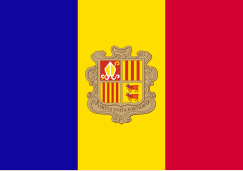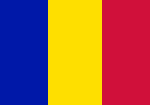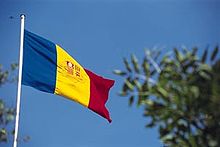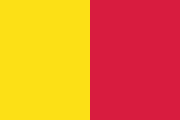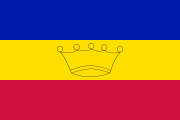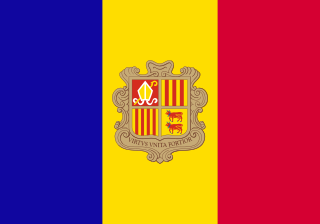
Andorra, officially the Principality of Andorra, is a sovereign landlocked country on the Iberian Peninsula, in the eastern Pyrenees, bordered by France to the north and Spain to the south. Believed to have been created by Charlemagne, Andorra was ruled by the count of Urgell until 988, when it was transferred to the Roman Catholic Diocese of Urgell. The present principality was formed by a charter in 1278. It is currently headed by two co-princes: the bishop of Urgell in Spain and the president of France. Its capital and largest city is Andorra la Vella.

A national flag is a flag that represents and symbolizes a given nation. It is flown by the government of that nation, but can also be flown by its citizens. A national flag is typically designed with specific meanings for its colours and symbols, which may also be used separately from the flag as a symbol of the nation. The design of a national flag is sometimes altered after the occurrence of important historical events. The burning or destruction of a national flag is a greatly symbolic act.
Andorra, officially the Principality of Andorra, also called the Principality of the Valleys of Andorra, is a sovereign landlocked microstate in southwestern Europe, located in the eastern Pyrenees mountain range and is bordered by Spain and France.

The national flag of Romania is a tricolour. The Constitution of Romania states that "The flag of Romania is tricolour; the colours are arranged vertically in the following order from the flagpole: blue, yellow, red". The flag has a width-length ratio of 2:3; the proportions, shades of colour as well as the flag protocol were established by law in 1994, and extended in 2001. Its similarity to the flag of Chad has caused international discussion.

The County of Urgell is one of the historical Catalan counties, bordering on the counties of Pallars and Cerdanya.

The flag of Serbia, also known as the Tricolour, is a tricolour consisting of three equal horizontal bands, red on the top, blue in the middle, and white on the bottom, with the lesser coat of arms left of center. The same tricolour, in altering variations, has been used since the 19th century as the flag of the state of Serbia and the Serb people. The current form of the flag was adopted in 2004 and slightly redesigned in 2010.

The coat of arms of Andorra is the heraldic device consisting of a shield divided quarterly by the arms of the Bishop of Urgell and the Count of Foix – who have historically been the two co-princes of Andorra – in addition to the emblems of Catalonia and the Viscount of Béarn. Utilized unofficially since the Middle Ages, its status as the coat of arms of the Principality of Andorra was formalized in 1993 upon the implementation of their new constitution. The escutcheon is featured on the flag of Andorra.

The Senyera is a vexillological symbol based on the coat of arms of the Crown of Aragon, which consists of four red stripes on a yellow field. This coat of arms, often called bars of Aragon, or simply "the four bars", historically represented the King of the Crown of Aragon.

Foix is a commune, the former capital of the County of Foix. It is the capital of the department of Ariège as it is the seat of the prefecture of that department. Foix is located in the Occitanie region of southwestern France. It is the second least populous French departmental capital, the least populous being Privas. Foix lies south of Toulouse, close to the borders with Spain and Andorra.

The co-princes of Andorra are jointly the heads of state of the Principality of Andorra, a landlocked microstate lying in the Pyrenees between France and Spain. Founded in 1278 by means of a treaty between the bishop of Urgell and the Count of Foix, this unique diarchical arrangement has persisted through the Middle Ages to the present. Currently, the bishop of Urgell and the president of France serve as Andorra's co-princes, following the transfer of the count of Foix's claims to the Crown of France and, subsequently, to the head of state of the French Republic. Each co-prince appoints a personal representative, the episcopal co-prince by Josep Maria Mauri and the French co-prince currently being represented by Patrick Strzoda.

The Crown of Aragon was a composite monarchy ruled by one king, originated by the dynastic union of the Kingdom of Aragon and the County of Barcelona and ended as a consequence of the War of the Spanish Succession. At the height of its power in the 14th and 15th centuries, the Crown of Aragon was a thalassocracy controlling a large portion of present-day eastern Spain, parts of what is now southern France, and a Mediterranean empire which included the Balearic Islands, Sicily, Corsica, Sardinia, Malta, Southern Italy and parts of Greece.

The flag of Crimea is the flag of the Autonomous Republic of Crimea in Ukraine and the Republic of Crimea controlled by Russia. The flag was officially adopted on 24 September 1992 as the flag of the Republic of Crimea, readopted on 21 April 1999, then readopted on 4 June 2014 as the flag of the Republic of Crimea, annexed by the Russian Federation.

Roger-Bernard III was the Count of Foix from 1265 to his death. He was the son of Roger IV of Foix and Brunissende of Cardona. He entered into conflicts with both Philip III of France and Peter III of Aragon, who held him in captivity for a time. He was nevertheless a distinguished poet and troubadour.

Futbol Club Andorra is a professional football club based in Andorra la Vella, Andorra, that currently competes in Segunda División, the second tier of the Spanish league system. The club was founded in 1942 and currently plays its home fixtures at Estadi Nacional. In spite of being based in the microstate of Andorra, the club, voluntarily affiliated to the Catalan Football Federation, has been allowed to compete in Spanish leagues since 1948. FC Andorra will play in the Primera Federación following relegation from the Segunda División

The flag of Naples is a vexillological symbol of the city of Naples, the capital of the Southern Italian region of Campania. The current flag representing the city consists of two equal-sized rectangles: golden yellow on the left and red on the right side.

The so-called Bars of Aragon, Royal sign of Aragon, Royal arms of Aragon, Four Bars, Red Bars or Coat of arms of the Crown of Aragon, which bear four red pallets on gold background, depicts the familiar coat of the Kings of Aragon. It differs from the flag because this latter instead uses bars. It is one of the oldest coats of arms in Europe dating back to a seal of Raymond Berengar IV, Count of Barcelona and Prince of Aragon, from 1150.

The colors of the national flag of Romania has a long history, though the association of the three colors only dates to the 18th century. Red, yellow and blue were found on late 16th-century royal grants of Michael the Brave, as well as shields and banners. Thus, the late 13th century Wijnbergen armorial shows the coat of arms of the Wallachian ruler Litovoi as consisting of a shield of ten vertically alternating gold-and-red bands,. The same two colors, gules and or, also appeared on the late 15th century flag and coat of arms of Moldavia, during the reign of Stephen the Great. Then, from the late 16th century until the mid-17th century, the historical coat of arms of Transylvania gradually developed as a shield party per fess, consisting of a black eagle on blue background in the upper field, a dividing red band in the middle, and seven red towers on golden background in the lower field. Finally, in the last quarter of the 18th century, Bukovina gets its own coat of arms from the Habsburg Empire, a blue-and-red shield party per pale with a black aurochs' head in the middle, and three golden six-pointed stars surrounding it. During the Wallachian uprising of 1821, these three colors were present, along others, on the canvas of the revolutionaries' flag and its fringes; for the first time a meaning was attributed to them: "Liberty (blue-sky), Justice, Fraternity ( blood)".

The flag of the Second Spanish Republic, known in Spanish as la tricolor, was the official flag of Spain between 1931 and 1939 and the flag of the Spanish Republican government in exile until 1977. Its present-day use in Spain is associated with the modern republican movement, different trade unions and various left-wing political movements.

The flag of Yugoslavia was the official flag of the Yugoslav state from 1918 to 1992. The flag's design and symbolism are derived from the Pan-Slavic movement, which ultimately led to the unification of the South Slavs and the creation of a united south-Slavic state in 1918.
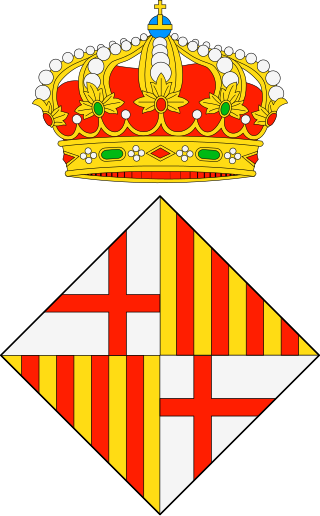
The coat of arms of Barcelona is the official emblem of the City Council of Barcelona, the capital of Catalonia, has its origin in the Middle Ages, these arms were first documented in 1329. The Government of Catalonia conferred the coat of arms and the flag as official symbols of the municipality in 2004. It has an escutcheon in lozenge which is commonly used in municipal coats of arms of cities in Catalonia. Currently the City Council of Barcelona also uses an isotype based on the heraldry of the city.
